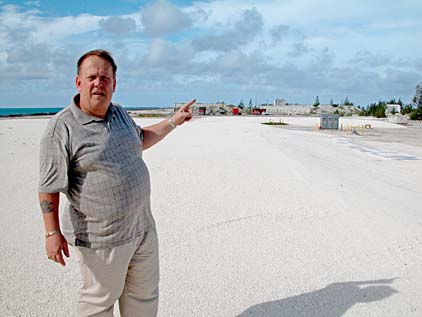
GREGG K. KAKESAKO / GKAKESAKO@STARBULLETIN.COM
Former Johnston Atoll worker Dale Druyor, standing on three feet of crushed coral over a razed chemical weapons incinerator, pointed to bunkers that will remain when the military leaves.
Atoll workers
‘made a difference’
JOHNSTON ISLAND >> Dale Druyor returned here yesterday for the last time, feeling a sense of closure.
"Today is closure for the island. It's also closure for me. It's time to say goodbye and that's what I am doing," said Druyor, 57, who has worked since 1988 with the U.S. Army as it cleared the island of chemical weapons.
Yesterday, as he stood on a 3-foot-high mass of coral covering more than 50,000 square feet, Druyor recalled the more than 20 trips he has made to Johnston over a span of 13 years, beginning in 1988.
Where Druyor was standing once housed the country's first chemical weapons incinerator beginning in 1990. It destroyed 412,000 chemical weapons containing mustard and nerve agents.
But for Druyor and Gary McCloskey, who lived here for 18 years -- 13 of them running the Johnston Atoll Chemical Agent Disposal System -- Johnston was more than just a job.
"The real essence of JACADS was its people," McCloskey said.
Later, at a brief ceremony marking the demolition of the incinerators and operations center, McCloskey singled out several individuals for their efforts during its 18 years of operations. Almost 75 people who had worked at the disposal system returned here for one more visit.
The chemical weapons disposal facility was built in 1985 after Congress ordered the Army to destroy its stockpile of chemical weapons. Its assembly line shut down 15 years later, but it took the Army until this summer to demolish the facility and clean up the area.
At the height of its operations, the incinerator had 1,400 workers -- about 250 military -- who braved typhoons, sunburn, loneliness and isolation -- to work on an island that is only 1.7 square miles in area and 825 miles southwest of Honolulu. Today, there are fewer than 300 workers at the site.
"I loved the job," said Druyor, who worked on Johnston from 1988 to 1990 and again for another year in 2000. "Other than living away from my family, it was a great job. And corny as it may sound, I think we made a difference. We got rid of some nasty stuff."
McCloskey added: "I have a remarkably good feeling of what we did. We eliminated something that was terrible."
Lt. Col. Mark Hostletter, who commands the last remaining military unit on Johnston -- Detachment 1 of the 15th Airlift Wing -- said that "every attempt will be made to save the government millions of taxpayer dollars by recycling a lot of the equipment here."
Everything -- furniture, office supplies, vehicles, large equipment like the island's reverse-osmosis water purification system -- will be sent to other military installations.
There were a few minor incidents through the years, McCloskey said, but no one was injured or killed by the accidental release of chemical agents. There was one industrial accident in the mid-1990s, but that had nothing to do with chemical disposal, he added.
"The tremendous lesson learned," McCloskey said, "is the principle involving safety culture. People have to expect safety to be part of the job."
